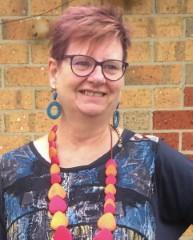PO Box 182
Yarragon
Vic 3823
Liz Harbridge

Liz Harbridge is an artist who works mainly with fabrics and found objects. She compliments these with eco dyeing, fabric manipulation, machine and hand stitching.
These days much of her inspiration comes from her excursions to charity shops, bush walking, fashion shows, dystopian and historical and fantasy movies. However as a child she began using upcycled clothing and factory offcuts to make dolls clothes, rag dolls and toys. Later she spent a few years using oils acrylics and pastel for drawing and painting.
Liz is very inspired by the colours and textures of certain landscapes and outdoor areas and takes time to do a few sketches, write down her emotional reactions then looks for materials. Her materials often include bones, sticks and rubbish collected as she walks.
In keeping with her love of vibrant colours and textures and all things eclectic Liz says she gains inspiration from the work of Frida Kahlo but also loves the subtle, Art Nouveau inspired paintings of Sydney Long.
When asked to describe her style Liz said it is eceletic, a demonstration of resourcefulness, because she uses what she can find or source from charity shops, garage sales, donations, and discarded things while on bush walks. Her upcycled fashion and wearable art aesthetic is mostly bohemian, shabby chic, steampunk and dystopian.
Liz has had an interest in art since early childhood so much of her work is her natural talent but she has dipped her toes into some formal training. She completed some subjects of the Diploma of Visual Arts at Yallourn TAFE but couldn’t complete the whole diploma due to work and family commitments. Naturally her favorite subject was material studies and mixed media.
Occasionally Liz conducts workshops or demonstrations using upcycled clothing and creating wearable art. She is proud that she sold a piece of mixed media called “The Mad Woman’s Underclothes” to the Monash University Student Union. This was a collage of bras and undies spray painted and mounted on board. She obviously receives many favourable comments from groups focusing on upcycling and re-cycling clothing.
It is no surprise therefore that Liz has become more experimental and more couragegous in exploring texture, and materials through her determination to spread the important message of repurposing textiles. Maybe in the near future she will extend her art practice to metalwork and building from recycled timber.
